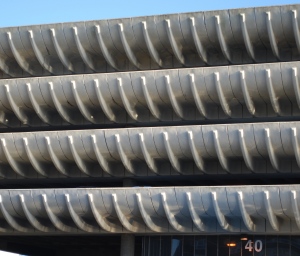This website uses cookies
This website uses cookies to enable it to function properly and to analyse how the website is used. Please click 'Close' to accept and continue using the website.



It is now more than three years since the Society submitted a second spot-listing application for Preston’s ‘Central Bus Station and Car Park’. I remember spending endless hours going through the building’s massive case file and submitting a lengthy listing application to English Heritage. But neither this, nor EH’s Advice Report strongly recommending listing at Grade II, convinced the DCMS to add the Building Design Partnership’s 1969 Bus Station to the Statutory List.
Disheartening though this news was, the building was, and is, still standing. Its proposed demolition and redevelopment was subject to substantial investment which, given the economic climate, was by no means guaranteed. Indeed, over the last six months, Preston City Council has been progressively shifting its position. In late July, on the same day that the 2011 Stirling Prize short list was announced, the Lancashire Evening Post revealed that the proposed Tithebarn regeneration scheme was going ‘back to the drawing board’. As we wrote on our blog, these two pieces of news seemed to herald a golden opportunity for the city: if two refurbishment schemes were shortlisted for the nation’s top architectural prize, if heritage experts repeatedly argued for the building’s special architectural interest, and if polls confirmed the building’s local popularity, then a new and imaginative approach could be more than a promising possibility: it might even secure a Stirling Prize for Preston in the future.
There were further developments during the autumn: just as the anchor retailer for the Tithebarn scheme pulled out, the Society’s nomination of ‘British Brutalism’ was accepted for inclusion in the World Monuments Fund’s 2012 Watch List. The Bus Station was one of three examples we put forward as representative of this type of late modernism so important in the history of post-war British architecture (the others were the South Bank Centre in London and Birmingham Central Library). These buildings were also linked by their listing history: each had been recommended more than once for listing by English Heritage, but then been turned down by the Government. The Society’s WMF nomination proposed that an international architectural competition should be organised for the maintenance and re-use of Preston Bus Station.
International recognition of the Bus Station’s special architectural interest seems, at long last, to have caught the Council’s attention. Encouraged by the Society to see the fate of the regeneration scheme as an opportunity, the Council’s leader announced in November that the city was willing to look at options other than demolition.
The fight for the Bus Station has always had strong local support. A poll by the Post in August 2000 showed that 57 per cent of readers wanted the station to be given listed building status. Ten years later, in May 2010, another poll voted it the city’s favourite building. At the same time, to celebrate their first fifty years, BDP ran an online ‘Placebook’ where the public could vote for their favourite BDP building of all time. PBS came second and was, interestingly, the only building from BDP’s first decade to make the top ten (the others date from this century). People living, working or studying in Preston have recently been asked to sign a petition for the case to be discussed in full council. A vigorous campaign by John Wilson has ensured that this has now reached the 1,350 signatures needed.
Robust yet incredibly flexible, Preston Bus Station deserves to be looked after so that it can continue serving Preston for many decades to come. Whether listed or not, its heritage asset status cannot be questioned: it is a Preston landmark for which the overworked word ‘iconic’ seems appropriate. Can we at last expect a happy ending to this story? Well, it still has a long way to go but, for the first time in more than a decade, it looks like we are at least moving in the right direction.
Christina Malathouni

Become a C20 member today and help save our modern design heritage.